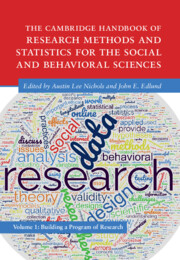 The Cambridge Handbook of Research Methods and Statistics for the Social and Behavioral Sciences
The Cambridge Handbook of Research Methods and Statistics for the Social and Behavioral Sciences Book contents
- The Cambridge Handbook of Research Methods and Statistics for the Social and Behavioral Sciences
- Cambridge Handbooks in Psychology
- The Cambridge Handbook of Research Methods and Statistics for the Social and Behavioral Sciences
- Copyright page
- Dedication
- Contents
- Figures
- Tables
- Contributors
- Preface
- Part I From Idea to Reality: The Basics of Research
- 1 Promises and Pitfalls of Theory
- 2 Research Ethics for the Social and Behavioral Sciences
- 3 Getting Good Ideas and Making the Most of Them
- 4 Literature Review
- 5 Choosing a Research Design
- 6 Building the Study
- 7 Analyzing Data
- 8 Writing the Paper
- Part II The Building Blocks of a Study
- Part III Data Collection
- Part IV Statistical Approaches
- Part V Tips for a Successful Research Career
- Index
- References
1 - Promises and Pitfalls of Theory
from Part I - From Idea to Reality: The Basics of Research
Published online by Cambridge University Press: 25 May 2023
- The Cambridge Handbook of Research Methods and Statistics for the Social and Behavioral Sciences
- Cambridge Handbooks in Psychology
- The Cambridge Handbook of Research Methods and Statistics for the Social and Behavioral Sciences
- Copyright page
- Dedication
- Contents
- Figures
- Tables
- Contributors
- Preface
- Part I From Idea to Reality: The Basics of Research
- 1 Promises and Pitfalls of Theory
- 2 Research Ethics for the Social and Behavioral Sciences
- 3 Getting Good Ideas and Making the Most of Them
- 4 Literature Review
- 5 Choosing a Research Design
- 6 Building the Study
- 7 Analyzing Data
- 8 Writing the Paper
- Part II The Building Blocks of a Study
- Part III Data Collection
- Part IV Statistical Approaches
- Part V Tips for a Successful Research Career
- Index
- References
Summary
We present an overview of the role, benefits, and drawbacks of theory in scientific research, particularly in the social and behavioral sciences. We discuss what theory is and what it is not. We also focus on some key elements of theory such as its ability to explain phenomena at multiple parallel levels of analysis. Evolutionary theory is offered as an example that illustrates the importance of conceptual integration across different disciplines. We further describe the key characteristics of good theories, such as parsimony, depth, breadth, and coherence (both internal and external), and we encourage the use of “coherence stress-tests” to help refine theory. We then discuss 4 advantages and 10 disadvantages of using theory in social and behavioral science research. Finally, we suggest conceptual tools and provide a list of recommendations for theory-driven research. We hope this chapter will help in the complex pursuit of improving research practices in the social and behavioral sciences.
Keywords
Information
- Type
- Chapter
- Information
- The Cambridge Handbook of Research Methods and Statistics for the Social and Behavioral SciencesVolume 1: Building a Program of Research, pp. 3 - 24Publisher: Cambridge University PressPrint publication year: 2023